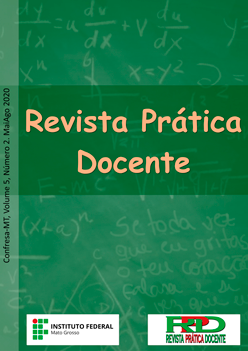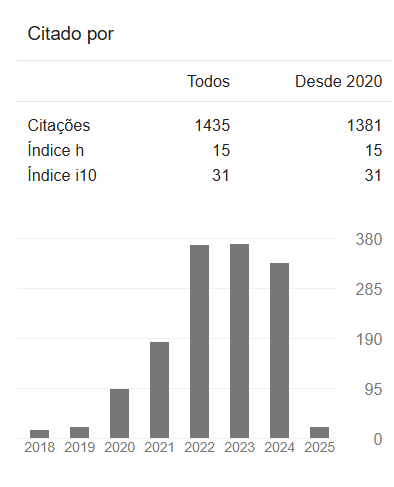A FIELD ACTIVITY IN THE SANTUÁRIO DO LIMA/RN: PROPOSAL FOR A GEOMETRY ACTIVITY
DOI:
10.23926/RPD.2526-2149.2020.v5.n2.p700-722.id782Keywords:
Field activity, Geometric concepts, Problem situations, Didactic sequence, Santuário do LimaAbstract
This article presents a master's research process that proposes a field activity as a methodology for the teaching of geometric concepts linked with problem situations. Was carried with students from the 9th grade of elementary, developed from the application of a didactic sequence, divided into three stages. In the first stage, the geometric concepts necessary for the development of the field activity were taught. In the second stage, the field activity was carried out at the Santuário do Lima, where the students solved pre-elaborated problem situations. In the third stage, learning assessment was carried out. Because of the application of the field activity, the students were able to observe and identify geometric concepts present in the buildings of the Santuário. The promotion of critical Mathematics Education, in a non-formal environment was able to collaborate with the formation of reflective students capable of giving meanings to concepts in their reality.
Downloads
Metrics
References
ARAÚJO, Denise Lino de. O que é (e como faz) sequência didática? Entrepalavras, v. 3, n. 1, p. 322-334, maio 2013. Disponível em: http://www.entrepalavras.ufc.br/revista/index.php/Revista/article/view/148/181.#. Acesso em: 29 jul. 2020.
BRASIL. Secretaria de Educação Fundamental. Parâmetros Curriculares Nacionais: Terceiro e Quarto Ciclo do Ensino Fundamental. Matemática. Brasília: MEC/SEF, 1998.
BOGDAN, Robert; BIKLEN, Sari. Investigação qualitativa em educação: uma introdução à teoria e aos métodos. Porto: Porto Editora, 1994.
CARBONELL, Jaume. A aventura de inovar: a mudança na escola. Porto Alegre: Artmed, 2002. (Coleção Inovação Pedagógica).
CARDOZO, Dionei; MENEGHELLI, Juliana; POSSAMAI, Janaína Poffo. Concepções dos professores de matemática quanto a utilização de exercícios, situações contextualizadas e problemas. Amazônia: Revista de Educação em Ciências e Matemáticas, v. 14, n. 31, p. 73-87, nov. 2018. Disponível em: https://periodicos.ufpa.br/index.php/revistaamazonia/article/view/5701/5001. Acesso em: 15 mar. 2019.
CARVALHO, Dione Lucchesi de. Metodologia do ensino da matemática. 4. ed. São Paulo: Cortez, 2011.
DANTE, Luiz Roberto. Didática da Resolução de Problemas de matemática. São Paulo: Ática, 1989.
D’ AMBROSIO, Beatriz Silva. Como ensinar matemática hoje? Temas e Debates. SBEM. Brasília, ano 2, n. 2, p. 15-19, 1989.
DE FRUTOS, José Antonio. et al. Sendas ecológicas: un recurso didáctico para el conocimiento del entorno. Madrid: Editorial CCS, 1996.
ECHEVERRÍA, María Del Puy Pérez; POZO, Juan Ignacio. Aprender a Resolver Problemas e Resolver Problemas para Aprender. In: POZO, Juan Ignacio (Org.). A solução de problemas: Aprender a resolver, resolver para aprender. Porto Alegre: Artmed, 1998. p. 13-42.
ELLIOTT, John. Action research for educational change. Milton Keynes: Open University, Press, 2004.
HANSEN, Karem Susan. Metodologias de Ensino da Educação Ambiental no Âmbito da Educação Infantil. Ciência e Educação, ano 11, n. 43, 2013.
SOUZA, Joamir Roberto de; PATARO, Patricia Rosana Moreno. Vontade de saber matemática. 3. ed. São Paulo: FTD, 2015. (9º ano)
THIOLLENT, Michel. Metodologia da pesquisa-ação. 18. ed. São Paulo: Cortez, 2011.
VIVEIRO, Alessandra Aparecida; DINIZ, Renato Eugênio da Silva. As atividades de campo no ensino de ciências: reflexões a partir das perspectivas de um grupo de professores. In: NARDI, Roberto. (org). Ensino de ciências e matemática I: temas sobre a formação de professores. São Paulo: Cultura Acadêmica, 2009, p. 27-42. Disponível em: http://books.scielo.org/id/g5q2h/pdf/nardi-9788579830044-03.pdf. Acessado em: 20 jan. 2020.
XAVIER, Odiva Silva; FERNANDES, Rosana César de Arruda. A Aula em Espaços Não-Convencionais. In: VEIGA, Ilma Passos Alencastro. Aula: Gênese, Dimensões, Princípios e Práticas. Campinas: Papirus Editora, 2008.
Downloads
Published
How to Cite
Issue
Section
License
Copyright (c) 2023 A Revista Prática Docente tem o direito de primeira publicação

This work is licensed under a Creative Commons Attribution-NonCommercial 4.0 International License.
Authors who publish in this journal agree to the following terms:
- Authors retain the copyright and grant the journal the right of first publication, with the paper simultaneously licensed under the Licença Creative Commons Attribution allows the sharing of the work with acknowledgment of authorship and initial publication in this journal.
- Authors are authorized to take additional contracts separately, for non-exclusive distribution of the version of the work published in this journal (e.g. publish in institutional repository or as a book chapter), with acknowledgment of authorship and initial publication in this journal.











